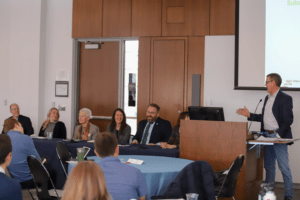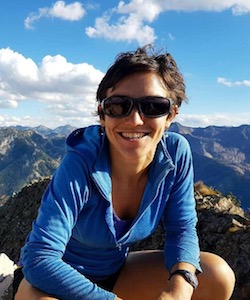By Danya Rumore
 This time of year, one thing seems to be on the mind of just about everyone in the Salt Lake Valley: air quality.
This time of year, one thing seems to be on the mind of just about everyone in the Salt Lake Valley: air quality.
Air quality is striking in the fact that pretty much everyone in the Salt Lake Valley agrees it is a problem and wants it to be improved. Yet, despite general consensus about the need to deal with our air quality problems and much political and technical progress on reducing emissions in the region, the problems persist—and are sometimes acute.
To bring people together to tackle the big question of what else needs to happen to “clear the air,” our Environmental Dispute Resolution (EDR) Program teamed up with partners at The Langdon Group to host our sixth Dialogue on Collaboration on “Collaborating on Air Quality: From Pollution to Solution” on Thursday, December 6. The event couldn’t have been more timely. Not only was the region experiencing an inversion and related smog, but, the morning of the event, Utah Governor Gary Herbert announced his budget recommendations for 2020, with $100 million set aside for air quality efforts.
Perhaps not surprisingly given the salience and visibility of the issue, we had a full house at the Dialogue, with over 80 people representing state and federal agencies, advocacy groups, industry, research bodies, and other stakeholder groups in attendance. Participants learned about collaboration—what it is, what it isn’t, and why it is important for addressing air quality. They also learned about the “wicked” nature of air quality issues: air quality is complex; it is not a singular, discrete problem; and there is no one, right, single solution for the problem, only better or worse interventions.
Get notified when new articles are posted to the EDR blog – sign up for our email list »
To help frame the conversation, six experts on regional air quality issues gave brief presentations on the Salt Lake Valley’s air quality situation. Thom Carter, the Executive Director of the Utah Clean Air Partnership (UCAIR), kicked off the conversation by explaining why people do—and should—care about air quality in the Salt Lake Valley. Kerry Kelly, an Assistant Professor in Chemical Engineering at the University of Utah, explained the science behind our air quality concerns. Alan Matheson, the Executive Director of the Utah Department of Environmental Quality, talked about policy and regulation related to air quality and related efforts in the region. Teri Newell, Deputy Director with the Utah Department of Transportation (UDOT), discussed what growth means for our air quality issue and what UDOT is doing to try to reduce transportation-related sources. Vicki Bennett, Sustainability Director for the Salt Lake City Corporation, shared examples of innovative strategies for addressing air quality. The final speaker, Ashley Miller, the Policy Director for Breathe Utah, wrapped up the presentation by sharing some examples of ongoing collaboration opportunities and grassroots efforts to address air quality issues in the region. Following their framing presentations, the speakers engaged in dialogue about challenges and opportunities for continuing to make progress on improving the valley’s air, especially amid continued rapid growth and development.
We then passed it over to participants to engage in their own small-group dialogues about a key element or aspect of the air quality challenge that was of most interest to them. Using Sli.do technology, which enables people to suggest ideas and questions and take polls via their mobile devices, we solicited participant suggestions about breakout session topics and then had participants vote on the three topics of greatest interest to them. The topics participants chose to discuss were: equity and air quality; increasing political will; key legislative priorities; ideas for uses for the Governor’s $100 million appropriation; transportation behaviors; transportation systems; economic and pricing strategies; energy use and behavior change; and managing growth to address air quality.
Each small group was tasked with identifying two or three key opportunities to address the aspect of air quality they chose to discuss, related barriers, what can be done to address those barriers, and who needs to be involved. They then were asked to think about one or two things they themselves could do to make progress on the air quality issue. The ideas for personal action that participants came up with ranged from simply lowering their thermostat, to changing their travel patterns, to lobbying the state legislature to continue to invest in and focus on improving our air quality.
Wanting to collect some real time data on participants’ perspectives and the impact of the event, we used Sli.do to do a pre- and post-event poll with participants. According to poll results, participants were more concerned about air quality in the valley as a result of the event. Importantly, following the Dialogue, they were also notably more optimistic that air quality issues in the Salt Lake Valley can be effectively addressed, and also that they will be addressed. Participants indicated they were also much more familiar with collaboration skills and concepts as a result of attending the event.
Like our participants, I also left the event feeling at once more concerned about our air quality and also more optimistic that we can and will deal with it. Here are a few other things I took away from the Dialogue:
- Great work and collaboration has already been done to improve air quality in the Salt Lake Valley, and we still have a sizeable challenge ahead of us to continue to improve our air quality, especially amid rapid regional growth.
- There is considerable opportunity—and, I would argue, a need—for key stakeholders representing different interests to work together to negotiate a regional strategy to improve air quality. Such a strategy would build on the DEQ’s State Implementation Plan by clarifying what different stakeholders (from agencies to industry to NGOs and others) can and will do together to present a united front and align efforts to make serious progress on our regional air quality issues. Importantly, such a strategy would need to have teeth to help hold different parties accountable for following through with their commitments to implement solutions.
- Finally, the event really drove home that bringing people together to learn from and with each other collaboratively can really empower people to make positive change—and to do so together.
For those of you who didn’t have a chance to participate, a video of the event and event materials are available via the EDR Program website. Additionally, in a time where positive news is hard to come by, we’re particularly pleased to note the event was covered by the Deseret News.
Our Dialogues on Collaboration are held twice a year, typically in June and December, and they are free and open to the public. They are part of the EDR Program’s Utah Program on Collaboration, which focuses on fostering a culture of collaboration around environmental and natural resource issues throughout Utah. We are deeply grateful for the support of our many partners, particularly The Langdon Group, and our sponsors for helping make the Dialogues and the broader Utah Program on Collaboration a reality.
We welcome suggestions for future Dialogue topics, as well as new partners and sponsors for the Utah Program on Collaboration. To learn more or to suggest ideas, please contact EDR Program Manager Katherine Daly.
 Danya Rumore, Ph.D., is the Director of the Environmental Dispute Resolution Program in the Wallace Stegner Center at the University of Utah. She is a Research Associate Professor in the S.J. Quinney College of Law and a Research Assistant Professor in the City and Metropolitan Planning Department at the University of Utah’s. She teaches about, practices, and conducts research on negotiation, dispute resolution, leadership, and collaborative problem solving.
Danya Rumore, Ph.D., is the Director of the Environmental Dispute Resolution Program in the Wallace Stegner Center at the University of Utah. She is a Research Associate Professor in the S.J. Quinney College of Law and a Research Assistant Professor in the City and Metropolitan Planning Department at the University of Utah’s. She teaches about, practices, and conducts research on negotiation, dispute resolution, leadership, and collaborative problem solving.
